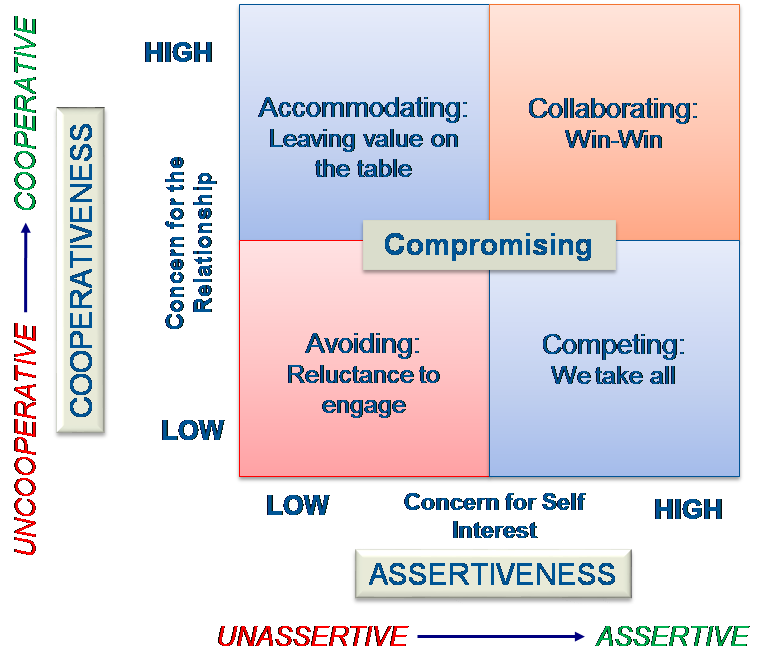For those of you that were hoping for the next chapter in – “Do You Know the Difference Between Strategic Sourcing and Category Management?”, my apologies. I thought I would change it up a bit this week, but I promise to go back there in my next post 🙂 ! This morning I saw an article from HBR “How People with Different Conflict Styles Can Work Together” and it made me think of one of my favorite modules from our Strategic Sourcing University – Negotiating Styles.
There are five common negotiating styles which are also considered to be conflict styles. The rationale for this is that most people perceive a negotiation to be an adversarial event where both parties will have opposing views and objectives. We all have a style that we are most comfortable with (we have a fun survey that helps you to determine that style) but to be a good negotiator you must be comfortable using any one of the five styles where appropriate.
Here is an illustration of the various styles:

Here are some definitions and guidance on when to use which style:
Avoiding: Ignoring the issues and the other party. Neither you or I satisfy our concerns.
Definition:
- Most unassertive and most uncooperative
- You don’t take a position
Characteristics:
- Postponing discussions or contact
- Avoid conflict and controversy
- Avoid situations that create discomfort
- Avoid open discussions of issues
- Withdrawing from negotiation
When To:
- Conflict involves a trivial matter
- Tempers flare and people need to cool down
- You need to gather more information
- Potential damage of confrontation outweighs the benefit
Accommodating: Focuses on the preservation or creation of the relationship, often at the expense of your own interest.
Definition:
- Low assertiveness and highly cooperative
- Opposite of Competing
Characteristics:
- Focus on other parties interests
- Preserve / build relationship at all costs
- Keep other party happy / don’t “hurt feelings”
- Focus on agreed issues versus disagreements
- Letting other party dictate terms
When To:
- The greater need is for harmony and stability
- You realize you are wrong
- The issue is much more important to the other party
- Continued competition would only damage the cause
Competing: Focuses only on the negotiator’s interests, often at the expense of the relationship.
Definition:
- Highly assertive and highly uncooperative
- Opposite of Accommodating
- Little interest in concerns of others
Characteristics:
- Taking advantage of all leverage opportunities and weaknesses without regard for other party
- Relentless pursuit of wants independent of value or need
- Positional based discussions and strategies
When To:
- When situations demand immediate actions
- When someone takes advantage of cooperative behavior
- Dealing with important issues that are unpopular
Collaborating: A win-win style based on mutual problem solving and can result in a long-term, mutually satisfying relationship
Definition:
- Both highly assertive and highly cooperative
- The most ideal position
- Takes the most patience and commitment
- Looking to build consensus
Characteristics:
- Requires skill, experience, and patience
- Seeks to satisfy interests of both parties
- Creative solutions that satisfy both parties
- Bringing issues and concerns into the open
- Dealing with issues that are important to all
When To:
- Concerns are too important to compromise
- There is a need to merge different insights
- The objective is to better understand the others views
- Increase commitment by incorporating others concerns
Compromising: Each party gives up some of their concerns to satisfy each other.
Definition:
- Moderately assertive and cooperative
- Thought of as “splitting the difference”
- Workable solution with a deadline
Characteristics:
- Working to find a solution that will partially meet each parties’ needs
- May need to be used when goals are not aligned and collaboration has failed
When To:
- Facing a deadline and you need a solution
- Temporary settlements are needed on complex issues
- Goals don’t match – each has equal power
- A back-up when collaborating or competing fail
In our training, we also discuss the common outcomes and potential negative consequences for each style if that is the predominant style that is used. Now let me get back to my original question – which one works best? Most people would answer collaborating but the real answer is “it depends”. Collaborating takes TIME and sometimes you don’t have it or you don’t need to invest that time in developing a relationship. The bottom line is that the best negotiators are comfortable using ALL the styles and know the appropriate time and situation to use them. Sometimes certain styles are just too uncomfortable for an individual – in that case bring someone along with the ability to use that style on your behalf (e.g. another member of your negotiating team).
Which style do you think best represents you? Explore this question for yourself and get comfortable with the rest so you can be the best negotiator you can be 🙂 !
Join in the conversation and let us know what you think . . . . . . .

